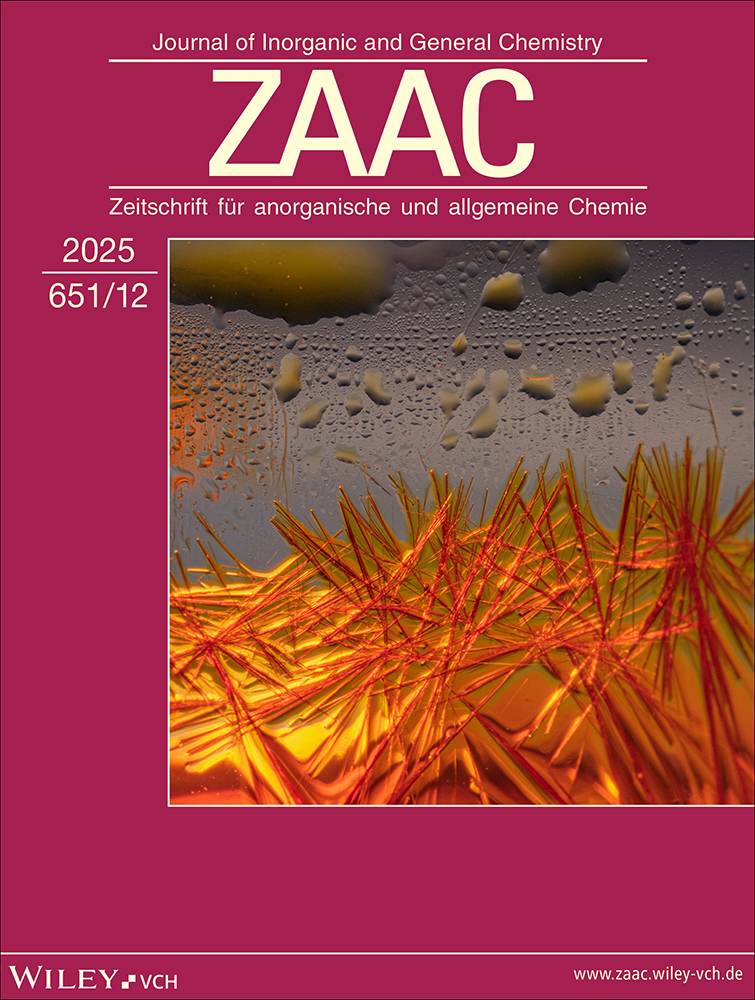Verbrückende Koordination von Gallium–Gallium-Bindungen durch Chelatliganden – Grenzen der Beständigkeit von Digallium-Verbindungen
Abstract
deDie Umsetzungen von Bis[bis(trimethylsilyl)methyl]-di(μ-acetato)digallium(Ga–Ga) (2) mit Lithium-2-amido-1-methylbenzimidazol in den molaren Verhältnissen von 1 : 1 bzw. 1 : 2 ergeben unter Abscheidung äquivalenter Mengen Lithiumacetat neue Digalliumverbindungen, in denen die Ga–Ga-Bindungen erhalten bleiben und jeweils von zwei Chelatliganden überbrückt werden. Durch Ersatz nur eines Acetatrestes entsteht Verbindung 5 mit zwei unterschiedlichen verbrückenden Liganden, wobei die Benzimidazolgruppe über die terminale Amidfunktion und das nicht an eine Methylgruppe gebundene Stickstoffatom des Heterozyklus koordiniert wird. Werden beide Acetatgruppen durch Benzimidazolreste ersetzt, lassen sich zwei Produkte nachweisen, in denen sich die Chelatliganden entweder durch eine Spiegelebene parallel zur Ga–Ga-Bindung (cis, 6) oder eine zweizählige Achse senkrecht zur Element–Element-Bindung (trans, 7) ineinander überführen lassen. 7 ist thermodynamisch stabiler und entsteht irreversibel beim Erhitzen des Gemisches. 5 und 7 werden kristallstrukturanalytisch charakterisiert, sie verfügen über Ga-Atome mit chiraler Umgebung. Setzt man schwächere Donoren, wie Diphenyl(lithiomethyl)(piperidinomethyl)silan, ein, das über sein carbanionisches Kohlenstoffatom und über das sterisch abgeschirmte Piperidin-Stickstoffatom an Gallium koordinieren kann, bleibt die Ga–Ga-Bindung nicht erhalten. Wir isolieren die einkernige Verbindung 8, in der das Galliumatom an eine Bis(trimethylsilyl)methyl-Gruppe und zwei (Piperidinomethyl)silyl-Reste gebunden ist. Ferner wird über die Synthese eines Dialkyl-bis(1,3-dionato)digallium-Derivates (9) berichtet, in dem die chelastisierenden 1,3-Dionato-Gruppen terminal an jeweils ein Ga-Atom der nicht verbrückten Ga–Ga-Bindung binden.
Abstract
enBridging Coordination of Gallium–Gallium Bonds by Chelating Ligands – Limitations of the Stability of Digallium Derivatives
The reactions of bis[bis(trimethylsilyl)methyl]-di(μ-acetato)digallium(Ga–Ga) (2) with lithium-2-amido-1-methylbenzimidazole in the molar ratios of 1 to 1 or 1 to 2 yielded by the precipitation of lithium aceatate new digallium compounds, in which the intact Ga–Ga bonds were bridged by two chelating ligands. The replacement of only one acetato group gave compound 5, that possesses two different bridging ligands with the benzimidazole group coordinated by its terminal amido function and that nitrogen atom of the heterocycle which is not attached to a methyl group. If both acetato groups were replaced by imdazole ligands, two products were obtained, in which the chelates are transferred in each other either by a mirror plane parallel to the Ga–Ga bond (cis, 6) or by a twofold rotational axis perpendicular to the element–element bond (trans, 7). 7 is thermodynamically favored and was irreversibly formed by heating of the mixture. 5 and 7 were characterized by crystal structure determinations and have Ga atoms in a chiral environment. Weaker donor ligands such as diphenyl(lithiomethyl)(piperidinomethyl)silane, which in principal is able to coordinate via its carbanionic carbon atom and more weakly via its sterically shielded piperidino nitrogen atom, led to the cleavage of the Ga–Ga bond. The mononuclear compound 8 was isolated, in which the Ga atom is attached to one bis(trimethylsilyl)methyl group and two (piperidinomethyl)silyl substituents. Furthermore, the synthesis of a dialkyl-bis(1,3-dionato)digallium derivative (9) is reported, in which the chelating 1,3-dionato groups are terminally coordinated to the Ga atoms of the unsupported Ga–Ga bond.




